Levin Kuhlmann
ILIF: Temporal Inhibitory Leaky Integrate-and-Fire Neuron for Overactivation in Spiking Neural Networks
May 15, 2025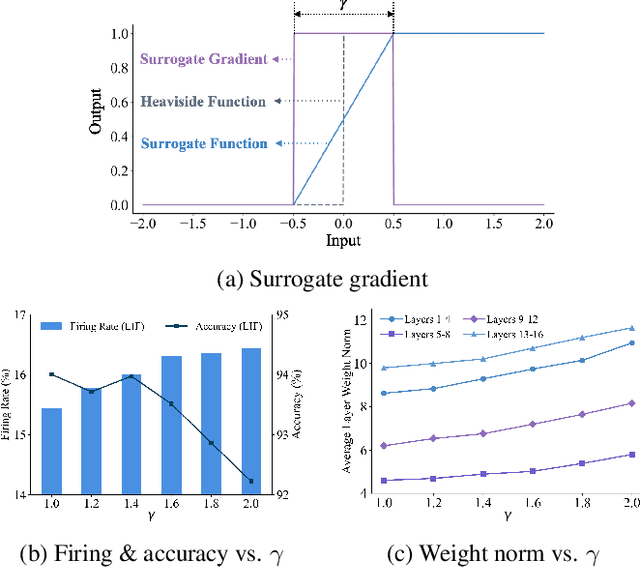
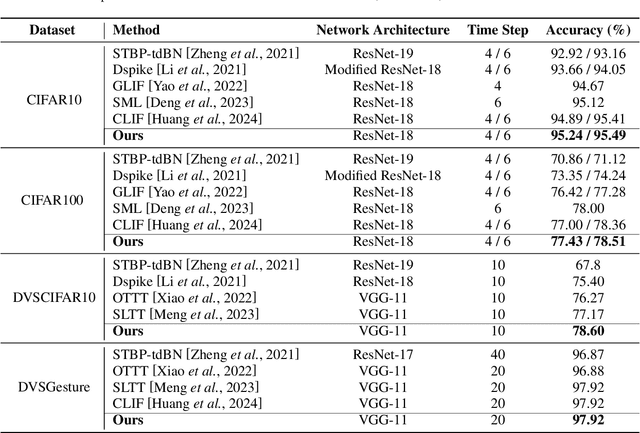


Abstract:The Spiking Neural Network (SNN) has drawn increasing attention for its energy-efficient, event-driven processing and biological plausibility. To train SNNs via backpropagation, surrogate gradients are used to approximate the non-differentiable spike function, but they only maintain nonzero derivatives within a narrow range of membrane potentials near the firing threshold, referred to as the surrogate gradient support width gamma. We identify a major challenge, termed the dilemma of gamma: a relatively large gamma leads to overactivation, characterized by excessive neuron firing, which in turn increases energy consumption, whereas a small gamma causes vanishing gradients and weakens temporal dependencies. To address this, we propose a temporal Inhibitory Leaky Integrate-and-Fire (ILIF) neuron model, inspired by biological inhibitory mechanisms. This model incorporates interconnected inhibitory units for membrane potential and current, effectively mitigating overactivation while preserving gradient propagation. Theoretical analysis demonstrates ILIF effectiveness in overcoming the gamma dilemma, and extensive experiments on multiple datasets show that ILIF improves energy efficiency by reducing firing rates, stabilizes training, and enhances accuracy. The code is available at github.com/kaisun1/ILIF.
Graceful task adaptation with a bi-hemispheric RL agent
Jul 16, 2024Abstract:In humans, responsibility for performing a task gradually shifts from the right hemisphere to the left. The Novelty-Routine Hypothesis (NRH) states that the right and left hemispheres are used to perform novel and routine tasks respectively, enabling us to learn a diverse range of novel tasks while performing the task capably. Drawing on the NRH, we develop a reinforcement learning agent with specialised hemispheres that can exploit generalist knowledge from the right-hemisphere to avoid poor initial performance on novel tasks. In addition, we find that this design has minimal impact on its ability to learn novel tasks. We conclude by identifying improvements to our agent and exploring potential expansion to the continual learning setting.
Augmenting Replay in World Models for Continual Reinforcement Learning
Jan 30, 2024



Abstract:In continual RL, the environment of a reinforcement learning (RL) agent undergoes change. A successful system should appropriately balance the conflicting requirements of retaining agent performance on already learned tasks, stability, whilst learning new tasks, plasticity. The first-in-first-out buffer is commonly used to enhance learning in such settings but requires significant memory. We explore the application of an augmentation to this buffer which alleviates the memory constraints, and use it with a world model model-based reinforcement learning algorithm, to evaluate its effectiveness in facilitating continual learning. We evaluate the effectiveness of our method in Procgen and Atari RL benchmarks and show that the distribution matching augmentation to the replay-buffer used in the context of latent world models can successfully prevent catastrophic forgetting with significantly reduced computational overhead. Yet, we also find such a solution to not be entirely infallible, and other failure modes such as the opposite -- lacking plasticity and being unable to learn a new task -- to be a potential limitation in continual learning systems.
Left/Right Brain, human motor control and the implications for robotics
Jan 25, 2024Abstract:Neural Network movement controllers promise a variety of advantages over conventional control methods however they are not widely adopted due to their inability to produce reliably precise movements. This research explores a bilateral neural network architecture as a control system for motor tasks. We aimed to achieve hemispheric specialisation similar to what is observed in humans across different tasks; the dominant system (usually the right hand, left hemisphere) excels at tasks involving coordination and efficiency of movement, and the non-dominant system performs better at tasks requiring positional stability. Specialisation was achieved by training the hemispheres with different loss functions tailored toward the expected behaviour of the respective hemispheres. We compared bilateral models with and without specialised hemispheres, with and without inter-hemispheric connectivity (representing the biological Corpus Callosum), and unilateral models with and without specialisation. The models were trained and tested on two tasks common in the human motor control literature: the random reach task, suited to the dominant system, a model with better coordination, and the hold position task, suited to the non-dominant system, a model with more stable movement. Each system out-performed the non-favoured system in its preferred task. For both tasks, a bilateral model outperforms the 'non-preferred' hand, and is as good or better than the 'preferred' hand. The Corpus Callosum tends to improve performance, but not always for the specialised models.
Coherent False Seizure Prediction in Epilepsy, Coincidence or Providence?
Oct 26, 2021

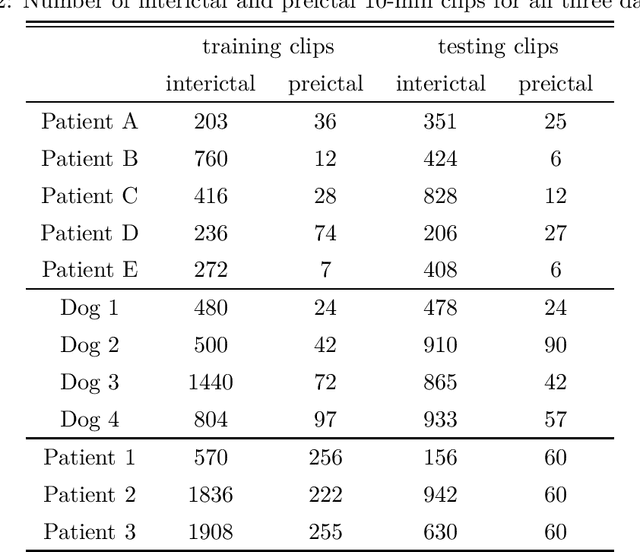

Abstract:Seizure forecasting using machine learning is possible, but the performance is far from ideal, as indicated by many false predictions and low specificity. Here, we examine false and missing alarms of two algorithms on long-term datasets to show that the limitations are less related to classifiers or features, but rather to intrinsic changes in the data. We evaluated two algorithms on three datasets by computing the correlation of false predictions and estimating the information transfer between both classification methods. For 9 out of 12 individuals both methods showed a performance better than chance. For all individuals we observed a positive correlation in predictions. For individuals with strong correlation in false predictions we were able to boost the performance of one method by excluding test samples based on the results of the second method. Substantially different algorithms exhibit a highly consistent performance and a strong coherency in false and missing alarms. Hence, changing the underlying hypothesis of a preictal state of fixed time length prior to each seizure to a proictal state is more helpful than further optimizing classifiers. The outcome is significant for the evaluation of seizure prediction algorithms on continuous data.
A Generative Model to Synthesize EEG Data for Epileptic Seizure Prediction
Dec 01, 2020
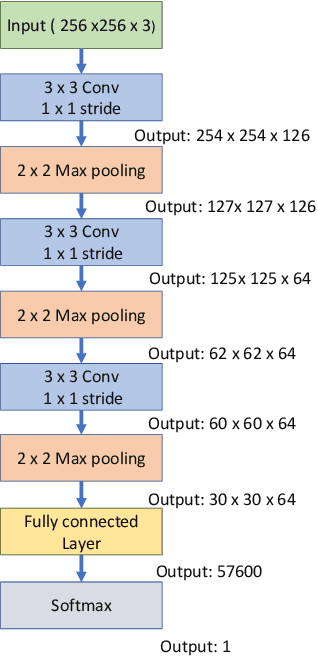
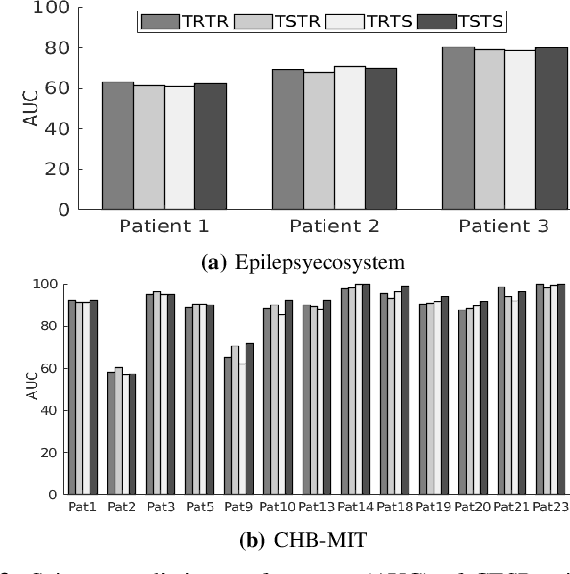
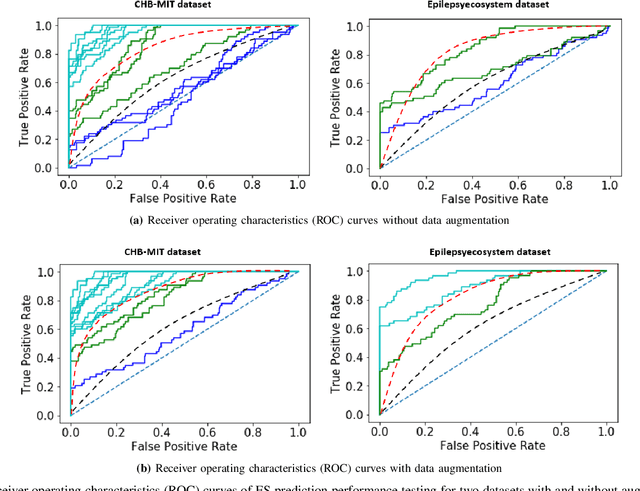
Abstract:Prediction of seizure before they occur is vital for bringing normalcy to the lives of patients. Researchers employed machine learning methods using hand-crafted features for seizure prediction. However, ML methods are too complicated to select the best ML model or best features. Deep Learning methods are beneficial in the sense of automatic feature extraction. One of the roadblocks for accurate seizure prediction is scarcity of epileptic seizure data. This paper addresses this problem by proposing a deep convolutional generative adversarial network to generate synthetic EEG samples. We use two methods to validate synthesized data namely, one-class SVM and a new proposal which we refer to as convolutional epileptic seizure predictor (CESP). Another objective of our study is to evaluate performance of well-known deep learning models (e.g., VGG16, VGG19, ResNet50, and Inceptionv3) by training models on augmented data using transfer learning with average time of 10 min between true prediction and seizure onset. Our results show that CESP model achieves sensitivity of 78.11% and 88.21%, and FPR of 0.27/h and 0.14/h for training on synthesized and testing on real Epilepsyecosystem and CHB-MIT datasets, respectively. Effective results of CESP trained on synthesized data shows that synthetic data acquired the correlation between features and labels very well. We also show that employment of idea of transfer learning and data augmentation in patient-specific manner provides highest accuracy with sensitivity of 90.03% and 0.03 FPR/h which was achieved using Inceptionv3, and that augmenting data with samples generated from DCGAN increased prediction results of our CESP model and Inceptionv3 by 4-5% as compared to state-of-the-art traditional augmentation techniques. Finally, we note that prediction results of CESP achieved by using augmented data are better than chance level for both datasets.
Machine Learning for Predicting Epileptic Seizures Using EEG Signals: A Review
Feb 04, 2020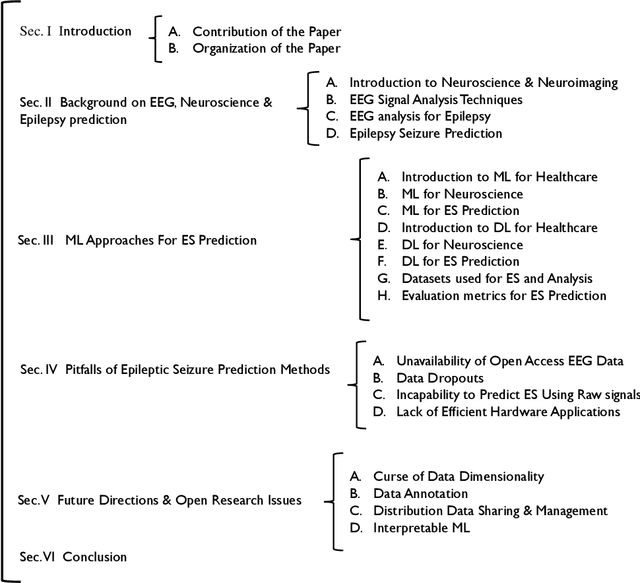
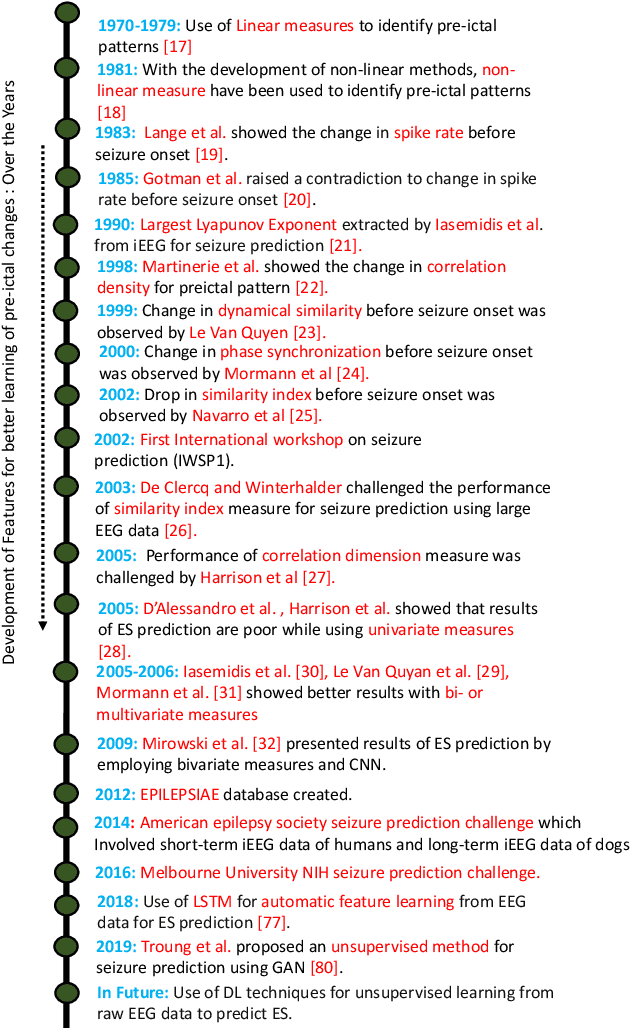

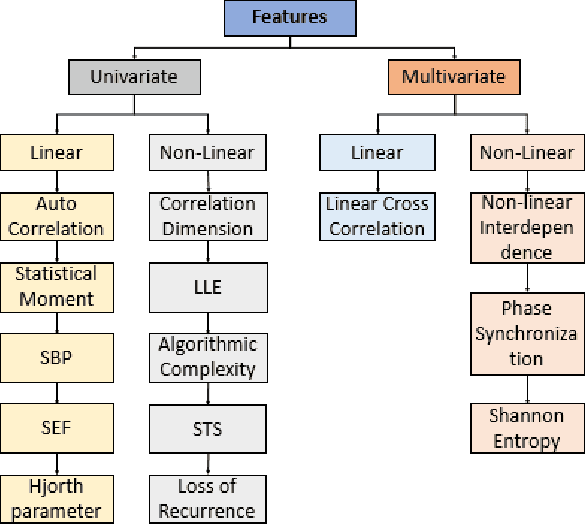
Abstract:With the advancement in artificial intelligence (AI) and machine learning (ML) techniques, researchers are striving towards employing these techniques for advancing clinical practice. One of the key objectives in healthcare is the early detection and prediction of disease to timely provide preventive interventions. This is especially the case for epilepsy, which is characterized by recurrent and unpredictable seizures. Patients can be relieved from the adverse consequences of epileptic seizures if it could somehow be predicted in advance. Despite decades of research, seizure prediction remains an unsolved problem. This is likely to remain at least partly because of the inadequate amount of data to resolve the problem. There have been exciting new developments in ML-based algorithms that have the potential to deliver a paradigm shift in the early and accurate prediction of epileptic seizures. Here we provide a comprehensive review of state-of-the-art ML techniques in early prediction of seizures using EEG signals. We will identify the gaps, challenges, and pitfalls in the current research and recommend future directions.
Human Intracranial EEG Quantitative Analysis and Automatic Feature Learning for Epileptic Seizure Prediction
Apr 07, 2019
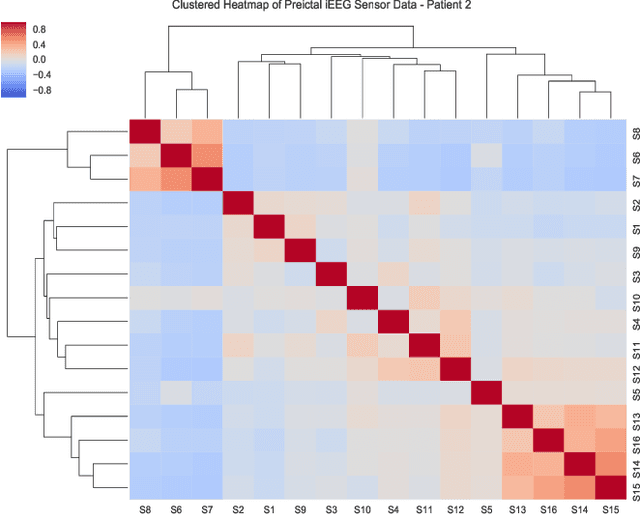
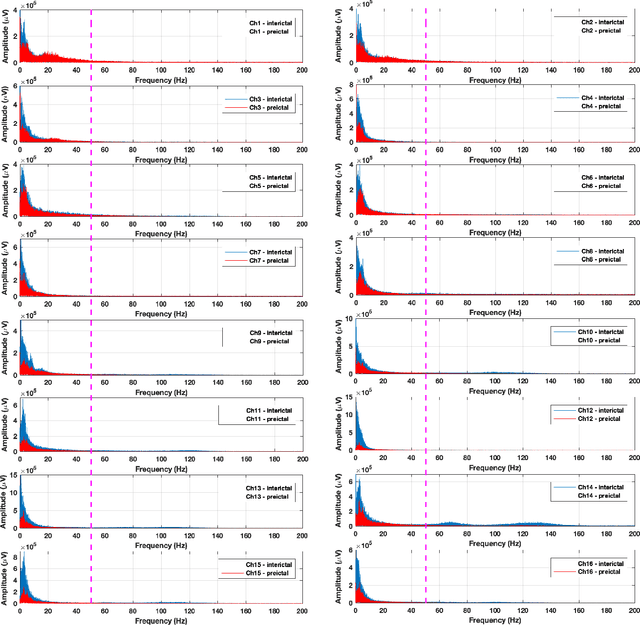
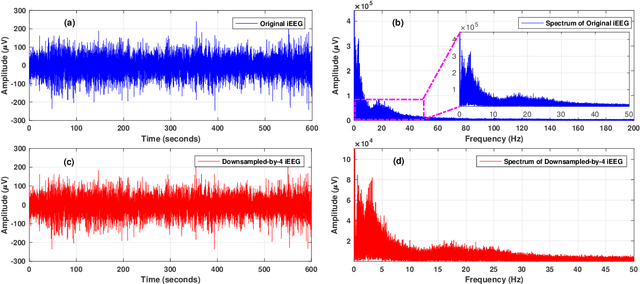
Abstract:Objective: The aim of this study is to develop an efficient and reliable epileptic seizure prediction system using intracranial EEG (iEEG) data, especially for people with drug-resistant epilepsy. The prediction procedure should yield accurate results in a fast enough fashion to alert patients of impending seizures. Methods: We quantitatively analyze the human iEEG data to obtain insights into how the human brain behaves before and between epileptic seizures. We then introduce an efficient pre-processing method for reducing the data size and converting the time-series iEEG data into an image-like format that can be used as inputs to convolutional neural networks (CNNs). Further, we propose a seizure prediction algorithm that uses cooperative multi-scale CNNs for automatic feature learning of iEEG data. Results: 1) iEEG channels contain complementary information and excluding individual channels is not advisable to retain the spatial information needed for accurate prediction of epileptic seizures. 2) The traditional PCA is not a reliable method for iEEG data reduction in seizure prediction. 3) Hand-crafted iEEG features may not be suitable for reliable seizure prediction performance as the iEEG data varies between patients and over time for the same patient. 4) Seizure prediction results show that our algorithm outperforms existing methods by achieving an average sensitivity of 87.85% and AUC score of 0.84. Conclusion: Understanding how the human brain behaves before seizure attacks and far from them facilitates better designs of epileptic seizure predictors. Significance: Accurate seizure prediction algorithms can warn patients about the next seizure attack so they could avoid dangerous activities. Medications could then be administered to abort the impending seizure and minimize the risk of injury.
Convolutional Neural Networks for Epileptic Seizure Prediction
Nov 05, 2018
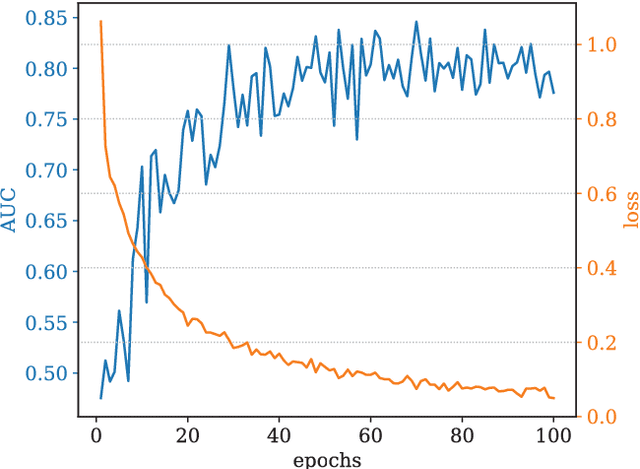
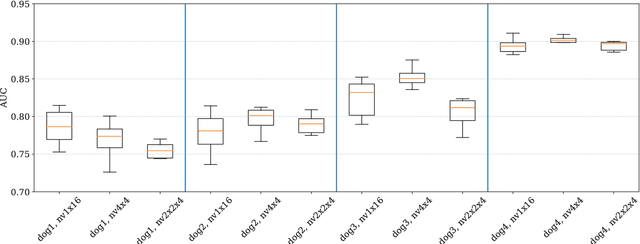
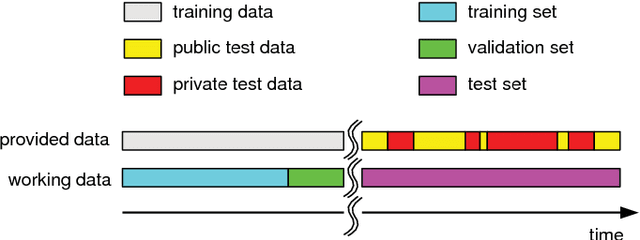
Abstract:Epilepsy is the most common neurological disorder and an accurate forecast of seizures would help to overcome the patient's uncertainty and helplessness. In this contribution, we present and discuss a novel methodology for the classification of intracranial electroencephalography (iEEG) for seizure prediction. Contrary to previous approaches, we categorically refrain from an extraction of hand-crafted features and use a convolutional neural network (CNN) topology instead for both the determination of suitable signal characteristics and the binary classification of preictal and interictal segments. Three different models have been evaluated on public datasets with long-term recordings from four dogs and three patients. Overall, our findings demonstrate the general applicability. In this work we discuss the strengths and limitations of our methodology.
Semi-supervised Seizure Prediction with Generative Adversarial Networks
Jun 20, 2018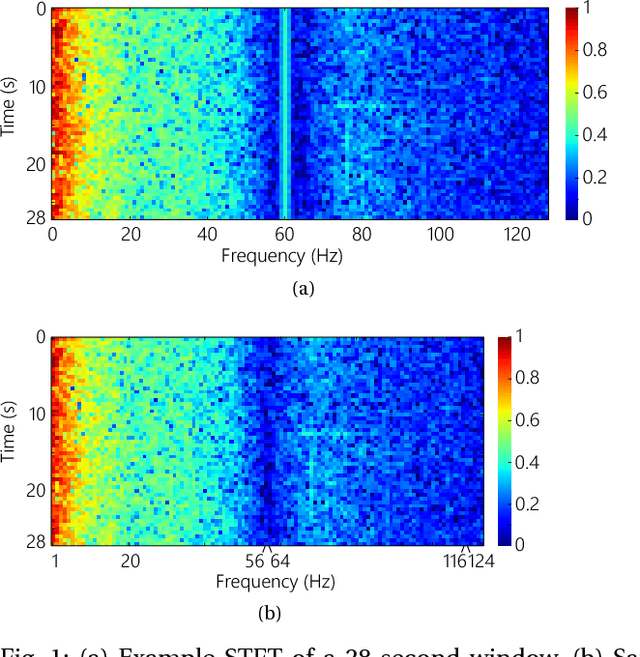
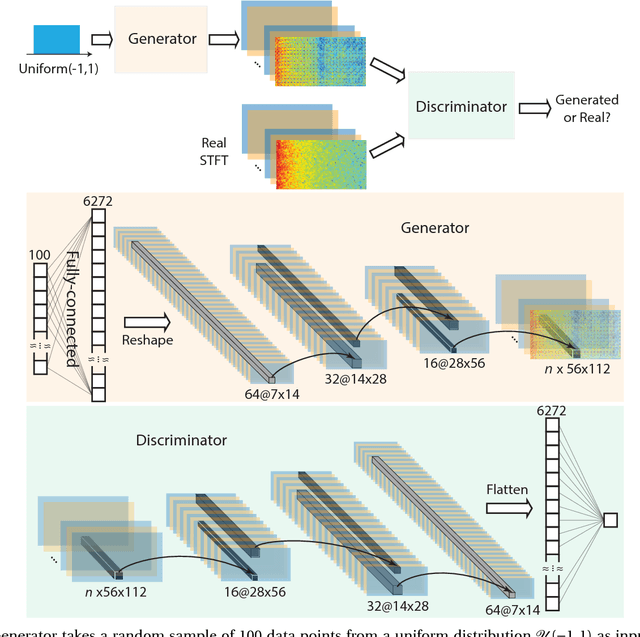


Abstract:In this article, we propose an approach that can make use of not only labeled EEG signals but also the unlabeled ones which is more accessible. We also suggest the use of data fusion to further improve the seizure prediction accuracy. Data fusion in our vision includes EEG signals, cardiogram signals, body temperature and time. We use the short-time Fourier transform on 28-s EEG windows as a pre-processing step. A generative adversarial network (GAN) is trained in an unsupervised manner where information of seizure onset is disregarded. The trained Discriminator of the GAN is then used as feature extractor. Features generated by the feature extractor are classified by two fully-connected layers (can be replaced by any classifier) for the labeled EEG signals. This semi-supervised seizure prediction method achieves area under the operating characteristic curve (AUC) of 77.68% and 75.47% for the CHBMIT scalp EEG dataset and the Freiburg Hospital intracranial EEG dataset, respectively. Unsupervised training without the need of labeling is important because not only it can be performed in real-time during EEG signal recording, but also it does not require feature engineering effort for each patient.
 Add to Chrome
Add to Chrome Add to Firefox
Add to Firefox Add to Edge
Add to Edge